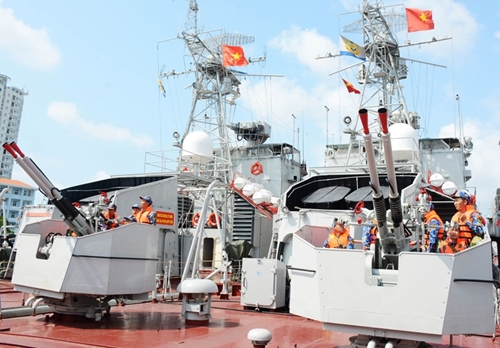Adhering to practical training
At 7:00 a.m., a long whistle on the anti-submarine ships of Brigade 171 (Naval Region 2) marks the start of a new training day for officers and soldiers. In the morning, Ship 15 conducts two training activities: training techniques of shooting the 37mm automatic air defense gun and introducing the features, structure, and operational principles of the PTA-40-159 torpedo launcher. Commanding officers organize training directly on the actual weapons, combining theoretical introduction with hands-on instruction of weapon components. During review sessions, soldiers practice directly on the artillery and launcher.
    |
 |
|
Assigning tasks to troops of Ship 15, Brigade 171, Naval Region 2 |
According to Lieutenant Commander Nguyen Binh Khanh, Captain of Ship 15, this training session is the next step after theoretical training and practice on models, aiming at testing the allocated vehicles, weapons, and equipment to ensure combat capacity in real combat conditions.
Brigade 171 has developed plans, setting specific objectives for each training content, considering this a crucial task that must be executed well to enhance the unit's training quality and combat readiness. This requirement ensures that training ammunition and target models are of realistic sizes. According to Captain Le Thanh Binh, Commanding Officer of Brigade 171, this training approach not only bridges the gap between theoretical and practical training, but also helps officers and soldiers understand deeply, grasp firmly, and perform their tasks confidently.
Mastering weapons and grasping tasks
In Naval Region 2, Radar Regiment 251 is equipped with modern, new radar systems. Therefore, the regiment's command always focuses on training and educating officers and personnel to use this equipment proficiently and effectively. Senior Colonel Tran Van Dau, Commanding Officer of Radar Regiment 251, shared, "To master modern equipment, the regiment combines various measures, including on-site training and sending officers and personnel to higher training courses, while also enhancing training in real combat conditions."
    |
 |
|
Practicing shooting aerial targets |
Similarly, combat ship brigades of Naval Region 2 emphasize mastering assigned weapons and equipment. Training sequences are clearly defined, suited to specialized tasks, and divided into different levels. Once personnel are proficient at basic levels, they undergo advanced training.
Captain Le Duc Thanh, Deputy Commanding Officer and Chief of Staff of Brigade 167, stated, "With the modern combat ship system, the brigade prioritizes nurturing personnel capable of exploiting and mastering on-board weapons and equipment."
This method is also effectively applied by Brigade 681, the Technical Supply Center, and the DK1 Platform Battalion, tailored to the specific conditions of each unit, thereby practically enhancing training quality, combat readiness, and the ability to master new generation weapons and equipment. Rear Admiral Nguyen Anh Tuan, Commander of Naval Region 2, emphasized, "The Party Committee and Command of the naval region prioritize comprehensive, in-depth training, closely aligned with combat reality, emphasizing practical application. This approach enhances the ability to master new, specialized weapons and equipment, especially within the combat ship brigades. Thanks to this, Naval Region 2 consistently fulfills training and combat readiness tasks, meeting the demands of firmly safeguarding the sacred national sea and islands."
Translated by Trung Thanh